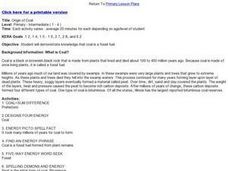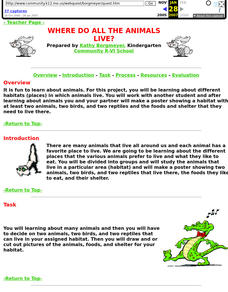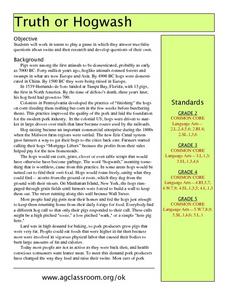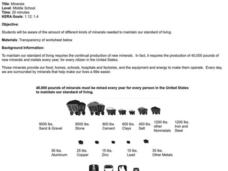Curated OER
Wetland in a Pan
Students examine wetlands and what the effects of destroying them will do. In this wetland activity students relate the importance of wetland functions to their own needs.
Curated OER
Wetland Habitats
Eighth graders explore the program Alice and the Internet to research wetland habitats. In this habitat lesson students build their own Alice world that includes wetland habitats, food sources and ways to protect the...
Curated OER
Double Trouble?
Students investigate cloned meat and animal products. In this food safety lesson, students research the noted Web sites in search of information about cloning and food labelling. Students use their findings to create informative...
Curated OER
Spark of Imagination
High schoolers consider the power of physics. In this current events lesson, students listen to a lecture that explores the power garnered by iPod batteries and how they work.
Curated OER
But That's Not FAIR!
Third graders solve problems using fractions through hands-on activities and appropriate literature.
Curated OER
What is Coal?
Pupils receive instruction to answer the question "What is coal?". They then participate in several puzzles and problems to explore the subject of coal. They solve addition and subtraction problems and match letters with the letter code...
Curated OER
Along Our Coast
Students explore the coast lines of Florida. They examine the benefits of estuaries and examine the estuary systems found along the coast. Students research and construct a saltwater food web.
Curated OER
Betty Mae Jumper and The Second Seminole War
Fifth graders describe the reasons for, nature of, and outcomes of the Second Seminole War. They determine that Seminole women and men faced many hardships as they fought for their survival. They relate a story of a Seminole "first"...
Curated OER
Precious Water: Is it a Need, a Right, or a Commodity?
Students determine whether water is a need, a right, or a commodity. In this water lesson, students investigate land and water ecosystems through activities. Students also discover water as a resource and energy source as they observe...
Curated OER
Where Do All the Animals Live?
Students study animal habitats and make a poster showing two animals, two birds, and two reptiles in their habitats.
Curated OER
Geological Time Line
Pupils demonstrate knowledge of when coal was formed by plotting a geological time line.
Curated OER
Aquatic Communities
Students watch a video about aquatic communities. They conduct an experiment that shows how movement of rivers change the landscape. They compare fresh and salt water communities and its wildlife.
Curated OER
Dino Detectives
As students examine maps of Utah, 4th graders search for clues about what prehistoric life was like in Utah.
Curated OER
Problems Encountered by Surveyors of Arkansas
Fifth graders examine the six geographic regions of Arkansas by examining the problems encountered by surveyors in Arkansas after the Louisiana Purchase. They conduct Internet research, create a chart, and write an essay comparing two...
Curated OER
Arkansas and Louisiana Purchase Wetlands
Students experiment to determine the value and importance of wetlands in Arkansas. They develop an environmental appreciation for wetlands.
Curated OER
Measuring Water Temperature
Students measure the temperature of three water sources. They collect data points every second for twenty five seconds for each sample using Lego Robolab temperature sensors, complete a worksheet, and analyze the data.
Curated OER
Using SWMP Data
Students are introduced to the SWMP system which tracks short-and long-term changes in water. Using this data, they plot and interpret the data on a graph to determine how human activities are lowering the water quality. They also...
Curated OER
Where Do You Fit In?
Students study habitats and then draw a picture of their own habitat which includes the location of food, water, and shelter, and the concept of space. then they cut their habitat in half and discuss how this would affect their lives.
Curated OER
Allison the Alligator
Second graders are introduced to the concepts of greater than and less than. This leads to the use of inequalities. The teacher tells the story about an alligator in order to create a fun environment for practicing the objectives of the...
Curated OER
Truth or Hogwash
Explore the history of domesticated pigs and their important byproducts. After discussing the use of pigs, class members create game boards describing the animals. While playing the game, they determine if the answers are true or...
Curated OER
Wetland Wonders
Young scholars describe the characteristics of wetlands. They demonstrate their understanding of the importance of wetlands to humans and wildlife and determine they are defined by the presence of water, and specialized soils.
Curated OER
Brine Shrimp 1: Hatching Brine Shrimp
Pupils review their prior knowledge on brine shrimp. In groups, they raise a group of brine shrimp and design an artificial environment in which they can live. They change the conditions of the environment to see how the shrimp react...
Curated OER
Minerals
Students become aware of the amount of different kinds of minerals are needed to maintain our standard of living by observing the worksheet. They study how it requires production of 40,000 pounds of new minerals and metals every year for...
Curated OER
Our Changing Environment-- A Demonstration
Students observe and describe changes in an environment when some of the components are changed. They recognize the process of succession by
preparing a miniaturized environment in which a variety of plants and seeds are grown.
Other popular searches
- Swamp Animals Habitats
- Cedar Swamp Nature Trail
- Swamp Angel
- Swamp Monsters
- Atlantic Cedar Swamp
- Cypress Swamp Food Chain
- Mangrove Swamps
- Swamps and Marshes
- Bayou Swamp
- Miss Swamp
- Swamp Habitat Destruction
- Bedtime at the Swamp























